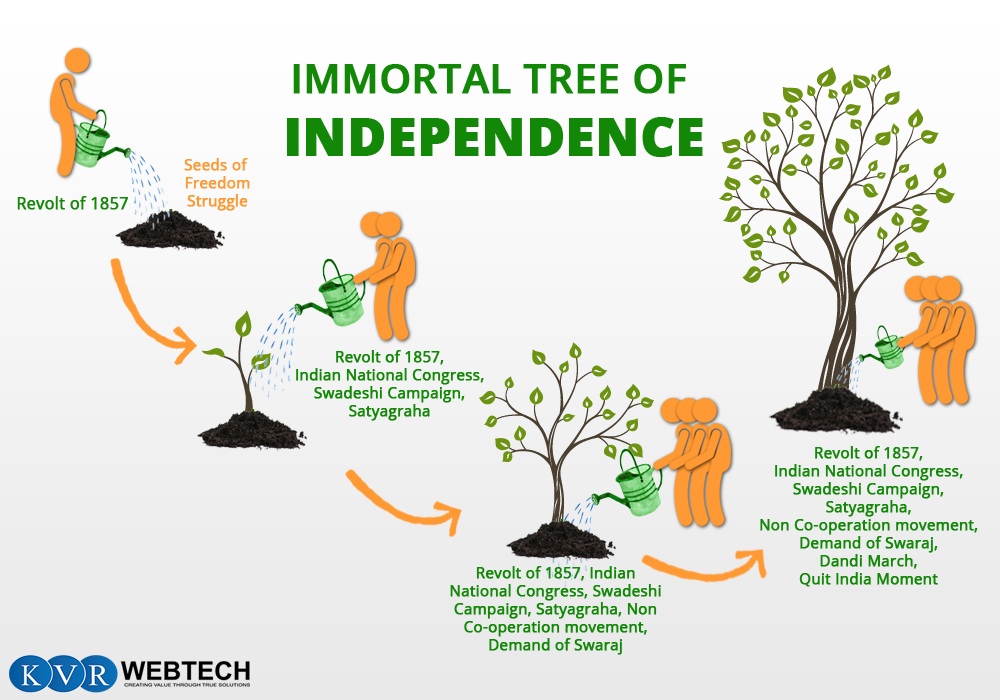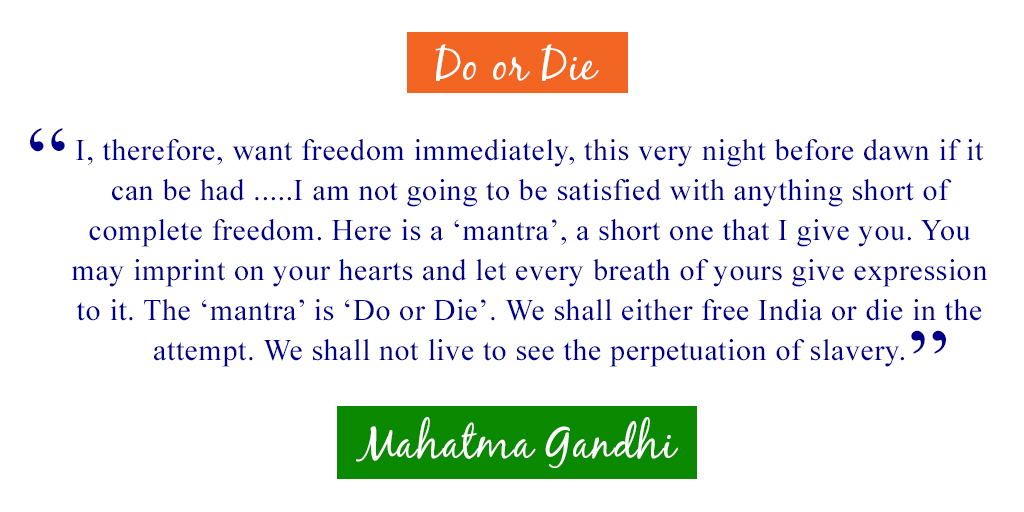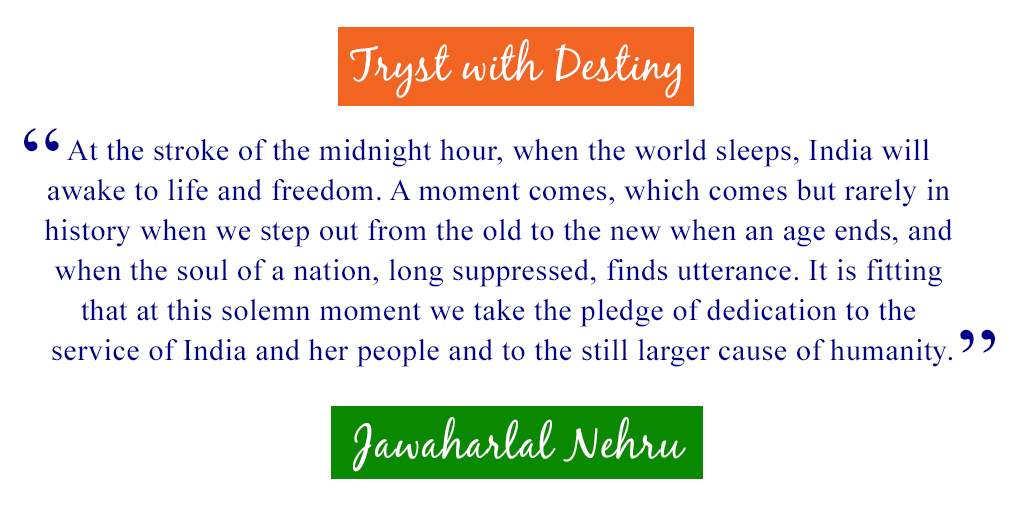
“Whether the aim is to win independence for your nation or to market the word about your company, you need a plethora of content. The kernel of content marketing is to convey your message to your targeted audience, thereby creating a snowball effect, generating thousands and millions of potential followers.”
The term ‘Content Marketing’ came into existence only in 1996, but it took birth a long back ago when content and marketing were treated as two different entities. The idea that marketing stands on the robust pillar of rich content has always been there. It is just that the formats of content and medium of its distribution have changed.
Content is not a sprint, it is a ‘Marathon Relay’
Indian freedom struggle was not a sprint instead it was a marathon relay that patiently and methodically unlocked our motherland from the shackles of British rule. The most formidable weapon with our freedom fighters that made this possible was CONTENT.
For instance one of the predominant ingredients of Gandhi’s non-violence strategy was content. He wrote content incessantly, even on days he had nothing to say, writing more than 10 million words over his lifetime or nearly as much as Stephen King. His continual effort finally paid off, building such a strong influence amongst the masses that he emerged as a ‘Father of Nation’ leading India towards independence.
Travel the journey that our freedom fighters traveled…
“The seeds of freedom struggle were patiently watered by rich, relevant and engaging content that finally resulted in flowering, immortal tree whose fruits are getting sweeter with every passing year.”
The struggle against the colonialism urged the masses to gather together and embark the long journey with a vision to attain ‘National Identity’ that was trapped in a cobweb designed by British. The sense of being oppressed under colonial rule provided a shared bond that tied different groups together and from these different groups emerged leaders who marketed their ‘views’ in form of ‘rich content’ that paved way for independence.

1.The Revolt of 1857 – Failure with a pinch of success
“Lack of vision, strategy, and research leads to a weak content and these three were also the major factors for the unsuccessful revolt of 1857.”
The revolt of 1857, also known as the first war of independence is one of the important events of Indian History whose failure laid a robust foundation for coming freedom struggle. It was a first rebellion against the East India Company that took the massive form. Unfortunately, the revolt was suppressed brutally. The rebellion was led by the soldiers/sepoy; hence it was also called as Sepoy Mutiny.
- Reasons for Failure:
• Weak ‘Planning’- The uprising was spontaneous and hence an unplanned act that was doomed to fail because of lack of any vision, strategy, unity, and planning.
• Frail ‘Marketing’- The uncertain timing of the revolt did not spread to all parts of the country.
• Feeble ‘Leadership’- Lack of strong political leadership resulted in this fiasco.
2. Lessons in 1857 gave birth to Indian National Congress in 1885
“Linking your content with relevant content reaches a higher number of targeted audience. Union of various political parties with a common aim of independence attracted myriad of supporters knocking the door of independence.”
Although the revolt of 1857 was a failure, its failure gave birth to various regional organizations that raised their voices against the British rule. Some of the active organizations were Bengal Indian Association, Bengal Presidency Association, Pune Public Meeting, etc. All these organizations had a common goal- ‘Freedom’.
Hence, all these little bubbles combined to form a lightning cloud in form of Indian National Congress in 1885 to raise their voices against the British Rule.
3. The ‘Swadeshi’ campaign of Bal Gangadhar Tilak and partition of Bengal (1905)
“A planned, focused campaign delivers fruitful results for your business in a long time. The campaigns effectively marketed by our freedom fighters delivered results that not only pushed back the British but also united India more strongly.”
The initial phase of Indian National Congress was run by Moderates who placed its demands before the government always in the form of petitions and worked within the framework of the law. Unfortunately, when their efforts did not bring many changes in the policies and administration of the British in India, a new set of thinking took birth in form of Extremists whose vision and power can be understood with the following happening:
In order to create a separate State for Muslims and to spread the poison of communalism in the country, the British came up with an announcement in 1905 to divide Bengal.
- The campaigns that forced the British to take a step back
The Indians viewed the partition as an attempt by the British to curb the growing national movement in Bengal and divide the Hindus and Muslims of the region. Organized meetings, processions and demonstrations paved way for the following strong campaigns:
- Swadeshi Campaign- Campaign that generated huge organic results
Bal Gangadhar Tilak introduced the concept of ‘Swadeshi’ (Now known as ‘Make in India’) and started a strong campaign attacking the British decision to divide Bengal. The campaign spread to all classes and groups of people delivering the following results:
• The use of Swadeshi goods, business, national education and Indian languages were encouraged.
• Swadeshi stores were opened.
• The Swadeshi Movement accompanied with boycott proved instrumental in the establishment of Swadeshi enterprises – Textile Mills, Banks, Hosiery, and Tanneries.
• Hindus and Muslims tied ‘Rakhi’ on each other’s hands to show their unity and their protest.
• The campaign forced the British to reverse their decision of dividing Bengal and hence united it in 1911.
It was during this phase of Indian National Congress when Bal Gangadhar Tilak came up with a viral slogan “Freedom is our birth right and we must have it”.
4. The ‘Non-Cooperation Movement’ campaign (1920-22) set a stage for many more fruitful campaigns
“The creative and structured content/campaign with relevant purpose strengthens the relationship between a business and customer. The campaigns forwarded by Gandhi during our freedom struggle were full of engagement, uniqueness, and relevance that urged more and more people to join the struggle for independence.”
After a series of events including the Jallianwala Bagh Massacre, the Non-Cooperation Movement was initiated by Mahatma Gandhi and Indian National Congress marking a new awakening in the Indian Independence movement. Gandhi realized that there was no prospect of getting any fair treatment at the hands of British; hence he planned to withdraw the nation’s co-operation from the British Government by launching the Non-Cooperation Movement. This movement almost shook the British authorities.
- Results of Non-Cooperation Movement:
• Built a relation between the Hindus and the Muslims and had created the height of Hindu-Muslim unity as a result of the merger of Khilafat movement.
• Mahatma Gandhi made the idea and need for Swarajya a more popular notion, which, in turn; created a new wave of patriotic enthusiasm.
• In Punjab, Akali Movement that was originally for reforms in the Gurudwaras got linked with the noncooperation movement, thereby leading to more unification.
• Promotion of Charkha and Khadi as the symbol of Indian nationalism helped Indian handloom products gain recognition.
5. Dandi March put the struggle of Indian Freedom in full pace
“When the content is thoroughly researched with positive efforts, it gets a platform of quality websites with good domain authority to reach a more targeted audience. Gandhi with its unique campaigns attracted masses of all ages, caste, and creed.”
During March-April, 1930, Gandhi marched from his Sabarmati Ashram to Dandi on the Gujarat coast for the purpose of raiding the Government Salt. The violation of salt law was his first robust challenge to the government. It was a peaceful yet most effective march supported by people of every section of India.
- The results of the Dandi March campaign created a snowball effect
• The campaign was joined and supported by farmers, traders, and women of India.
• It promoted unity among Indians of different regions under the Congress banner.
• It gave wide publicity to political ideas and methods throughout the country and generated political awareness even in remote villages.
• It provided an opportunity to recruit younger people and educate them for positions of trust and responsibility in the organization as also in provincial administration, which was captured in the 1937 elections.
The success of Dandi March along with Civil Disobedience Movement reached to the zenith and whole India pushed the British backward. Even British knew there is no coming back from here.
6. Quit India Movement – Final nail in the coffin of British rule
The various failed missions of the British to resolve issues with India finally left Indians frustrated and embittered. The discontent among Indian people was increasing due to wartime shortages and growing unemployment. Hence, India thought it is the best time to launch an attack in form of Quit India Movement.
The Congress under Gandhi felt that the British must be compelled to accept Indian demands or quit the country. Hence a movement was initiated and Gandhi addressed the Congress delegates with his soul-igniting speech:

The continual efforts of our nation finally forced the British to come up with an independence plan. In spite of strong opposition by Gandhi, all the parties agreed to the partition and the Indian Independence Act, 1947 came into existence.
It created two independent states in the Indian sub-continent, i.e. Indian Union and Pakistan. India got its independence on 15th August 1947. At the stroke of midnight (14th -15th August 1947), transfer of power took place and our first Prime Minister Jawaharlal Nehru came up with his famous speech: Tryst With Destiny

To be a good content marketer always remember “Be the change you wish to see on the web.”
- The content that wrote the history…
Bankim Chandra’s hymn to the Motherland, ‘Vande Matram’ became the rallying cry of patriotic nationalists. It inspired generations to supreme self-sacrifice. Simultaneously, it created a fear in the minds of the British. The impact was so strong that the British had to ban the song.

An enthusiastic Human Being with a zeal to express as much she can in words… and Blogs gave her a medium to express and share her knowledge. Has written for eminent blogs and fields like the social media, internet marketing, technology, lifestyle (tattoos, body art, fashion, etc.), politics, and the list is still increasing.

